1) BPL Ultima Prime Multipara Monitor
The BPL Ultima Prime D has a bright 12.1″ TFT high-resolution color display. In addition to the ability to carry out conventional measurements, it also contains a variety of extra capabilities such as a 168-hour trend review, patient ECG monitoring, CNS connectivity, rechargeable batteries, and medicine dose calculation.

FEATURES:
- ST Analysis and arrhythmia detection
- Displays up to 10 waveforms
- Drug dosage, HRV, and hemodynamic calculations
- Dual battery; efficient memory storage
2) GE Healthcare MAC 800 Multi-Parameter Monitor
The GE Healthcare MAC 800 Multi-Parameter Monitor is a reliable and affordable patient monitor that offers a wide range of features. It is available in both tabletop and portable versions, and features an easy-to-use interface.

FEATURES:
- Reliable
- easy-to-connect
- Proven efficient and accurate
- Portable
- simple user interface
3) Philips IntelliVue MP90 Patient Monitor
The Philips IntelliVue MP90 Patient Monitor is a high-end patient monitor that offers a host of features and advanced functionality. It has a simple UI and comes in both stationary and portable forms.

FEATURES:
- User-friendly NBP measuring display.
- Event Surveillance lowers information overload
- “Smart” patient information prioritising
4) Mindray uMAC10 Patient Multipara Monitor
Mindray’s uMEC 10 Patient Monitor provides high-quality monitoring at an affordable price for hospitals of all sizes. It’s ideal for clinical use because it provides reliable readings of key metrics.

FEATURES:
- High longevity
- low maintenance
- dependable monitoring
- cutting-edge performance
5) Schiller Truscope 3 Multipara Patient Monitor
This product offers Masimo-enabled 12.1″ touch screen multi-utility display. It has a 7-lead ECG display and performs ST/Arrhythmia analysis with 10 waveforms.
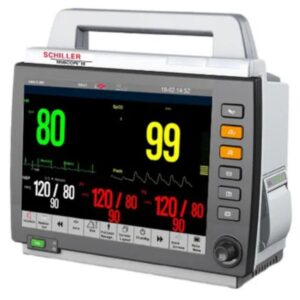
FEATURES:
- Display of 7-lead ECG
- ST & Arrhythmia analysis
- Display of a total of 10 waveforms at once
- 7-lead electrocardiogram (ECG) screen
- Recorder
- Video Output (VGA)
6) Philips IntelliVue MX400 Patient Monitor
The Philips IntelliVue MX400 Patient Monitor is a high-end patient monitor that offers a host of features and advanced functionality. It has a simple interface and can be utilised in a fixed or portable situation.

FEATURES:
- Clear and simple 9-inch touchscreen
- Clear division of menu items
- Adjustable Layouts of screens
- Prescription calculations, ventilation, hemodynamic, and oxygenation analysis
- Treatment plan administration using graphical and tabular trends
7) Spacelabs Healthcare Ultraview SL9000 Patient Monitor
The Spacelabs Healthcare Ultraview SL9000 Patient Monitor is a reliable patient monitor that provides excellent performance at an affordable price point. It offers a user-friendly interface and may be used in either a stationary or mobile setting.

FEATURES:
- patient monitoring
- central surveillance
- telemetry and ambulatory care
- clinical tools
- data sharing and integration
8) Edwards Lifesciences Vigileo Patient Monitor
The Edwards Lifesciences Vigileo Patient Monitor is a top-of-the line patient monitor that offers state-of-the art features and outstanding performance. It can be utilised in a fixed or moveable location, and its interface is straightforward.

FEATURES:
- Longevity
- cheap upkeep
- reliable monitoring
- state-of-the-art performance
9) Comen STAR8000E Cardiac patient monitor
The Comen STAR 8000 is a very sophisticated and high-quality patient monitor. It is robust and long-lasting, with excellent resistance to interference, because it was developed in accordance with CE regulations.

FEATURES:
- Touch-operated 12.1″ colour display.
- Arrhythmia/ST analysis
- ECG, Spo2, Respiratory, Dual Temp, NIBP
- Battery backup 3–4 hours
- USB interface for data storage and upgrading
- OXY CRG, ST Analysis, ARR Analysis, Drug Dose Calculation.
- 96 Hrs. Graphical & tabular Trends.
10) Comen Center Monitoring System Star8800
With the CMS VIEW software system, the STAR8000 may be used to set up a doctor’s observation station in any room of the hospital, so doctors can check in on their patients whenever they need to.

FEATURES:
- Dual 19-inch TFT monitors up to 128 items
- Standard high-performance laser printer
- Central monitoring with no software interference
- One single monitoring station can include foetal, multipara, and neonatal monitors
- Supports multiple languages.
Also Read – 10 Best Defibrillators in 2023
11) Welch Allyn Connex Spot Monitor
The Welch Allyn Connex Spot Monitor is a high-end patient monitor that offers a host of features and advanced functionality. It has a straightforward interface and may be used in either a fixed or mobile configuration.

FEATURES:
- Improve accuracy and performance for neonatal to adult patients
- Mobile stand with battery-powered work surface
- SureBP® technology provides BP in 15-seconds
- Detecto, Health o metre®, and SECA scale connection
- Averaging blood pressure to help diagnose hypertension
12) Spacelabs Healthcare Multi-Measurements Patient Monitor
The Spacelabs Healthcare Multi Measurements Patient Monitor is a reliable patient monitor that provides excellent performance at an affordable price point. It’s easy to use and can function in either a stationary or mobile setup.
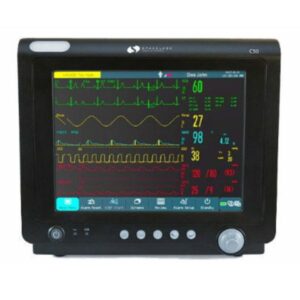
FEATURES:
- Portabile
- easy to use
- increased connectivity
- Long battery life
- dual battery capability
13) Dräger Infinity Delta XL Patient Monitor
The Dräger Infinity Delta XL Patient Monitor is a top-of-the line patient monitor that offers state-of-the art features and outstanding performance. It has a simple UI and comes in both stationary and portable forms.
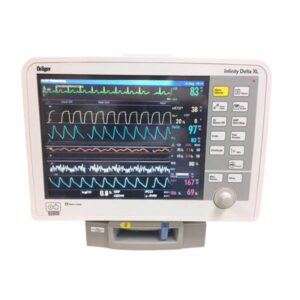
FEATURES:
- The screen is a 12.2″ TFT-LCD.
- 6 standard channels and 8 optional ones.
- 24-hour trend data storage for parameters.
- Rechargeable lithium-ion battery.
- Monitoring of neonates, children, and adults.
14) Siemens SC6000 Cardiac Monitoring System
The Siemens SC6000 Cardiac Monitoring System is a reliable and affordable patient monitor that offers a wide range of features. It’s available in both a fixed and a portable configuration, and features a straightforward user interface.
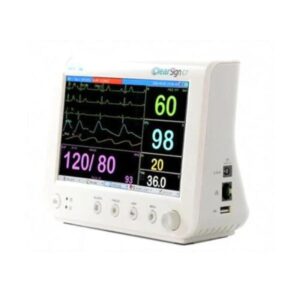
FEATURES:
- Appropriate for adults, children, and neonates.
- Installs to shelves, walls, and IV poles.
- Integral function NBP is included.
- Portable
15) Philips IntelliVue X2 Patient Monitor
The Philips IntelliVue X2 Patient Monitor is a high-end patient monitor that offers a host of features and advanced functionality. It may be used in either a stationary or mobile setting and has an uncomplicated UI.
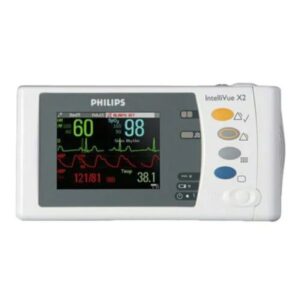
FEATURES:
- Touchscreen and hard key input.
- User-friendly interface.
- Patented automated alarm limits
- 3.5″ TFT flat panel display with QVGA (320 x 240) resolution
- Capable of functioning wirelessly
16) Dräger Infinity Gamma XL Patient Monitor
The Dräger Infinity GammaXL Patient Monitor is a reliable and affordable patient monitor that offers a wide range of features. Its straightforward user interface makes it suitable for both desktop and on-the-go use.
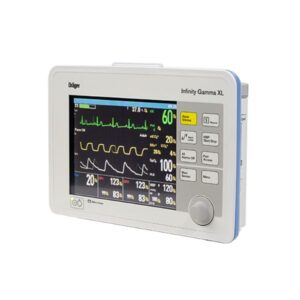
FEATURES:
- Compact and portable.
- ECG, basic arrhythmia, respiration, pulse rate, temperature, noninvasive blood pressure, and SpO2 are its standard parameters.
- Built for mid-acuity care with expandable features.
- Supports WPA2 and Wi-Fi (820.11g) wireless cards.
- Uses the Infinity Network or works independently.
- Continuous data gathering.
17) Mindray Beneview T5 Touch Screen Monitor
The Mindray Beneview T5 Touch Screen Monitor is a reliable patient monitor that provides excellent performance at an affordable price point. With its straightforward user interface, it’s suitable for usage in either a fixed or mobile scenario.

FEATURES:
- Displays and sounds alarms for patient or equipment issues.
- Displays, reviews, stores, and transfers real-time data.
- Includes buttons, knob, touchscreen, keyboard, and mouse.
- Interfaces a clinical information or central monitoring system.
- Network programme upgrading.
- Integrates anaesthetic machine, ventilator, and other device data.
18) GE Healthcare Dash 4000 Patient Monitor
Portable bedside monitoring solution Dash 4000 has a 10.4-inch screen. The Dash monitor is ideal at every point of care, from presentation in the ED to surgery in the OR, recovery in the PACU, treatment in the ICU, and transfer to the Stepdown unit.

FEATURES:
- 10.4” LCD display.
- Measures GE DINAMAP and SuperSTAT Non-Invasive Blood Pressure, SpO2, Temperature, and 3/5lead ECG.
- portable or mountable on a stand.
- batteries last 4-5 hours and charge in 3 hours.
- can monitor numerous modalities and offer fast, precise results for patient monitoring.
19) Contec CMS5100, 2 Para Patient monitor
Contec 2 para patient monitor adopts Oscillometry for measuring NIBP and Photoelectric Oxyhemoglobin Inspection Technology. Systolic, Diastolic, Mean, SpO2, and Pulse Rate (PR) can be monitored correctly. Hospitals, community medical treatment, and families can use this compact, functional, and easy-to-use device.

FEATURES:
- Built-in Li-polymer battery for continuous monitoring.
- easy-to-use.
- SYS, DIA, MAP, SpO2, and PR alarms with higher and lower limits.
- Unique Flash memory stores 2000 NIBP and 78000 SpO2 data.
20) Spacelabs Healthcare SC8000 Patient Monitor
The Spacelabs Healthcare SC8000 Patient Monitor is a reliable patient monitor that provides excellent performance at an affordable price point. It may be used in both stationary and portable forms because of its intuitive interface.
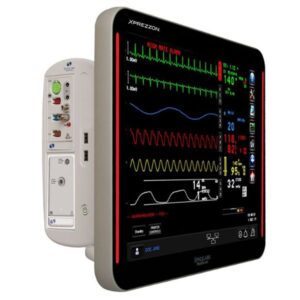
FEATURES:
- Lightweight
- Ease of Use
- Enhanced Connectivity
- Longer Battery Life
- Dual Battery Capability
- Portability
Frequently Asked Questions (FAQs)
What is a patient monitor used for?
A patient monitor is a medical device used to continuously monitor a patient’s vital signs, such as heart rate, blood pressure, respiratory rate, and oxygen saturation. It is commonly used in hospitals, clinics, and emergency rooms to detect any changes in the patient’s condition and provide early warning of any potential problems.
What is the use of patient monitor in ICU?
In an ICU (Intensive Care Unit), patient monitors are used to continuously monitor critically ill patients and their vital signs, providing healthcare providers with real-time information about the patient’s condition. This information can include heart rate, blood pressure, respiratory rate, oxygen saturation, and other important parameters.
What are the two types of patient monitor?
The two main types of patient monitors are:
- Portable patient monitors: These are compact and portable devices that can be easily moved from one location to another. They are typically used in outpatient settings, emergency departments, and during patient transport.
- Stationary patient monitors: These are larger, more sophisticated devices that are permanently installed in hospital rooms and ICUs. They are typically connected to the hospital’s central monitoring system and can monitor multiple patients at once.
Both types of patient monitors can measure vital signs such as heart rate, blood pressure, respiratory rate, and oxygen saturation, among others. They provide healthcare providers with real-time information about the patient’s condition, allowing for early intervention and improved patient outcomes.
How do you check a patient monitor?
Here are some general steps to check a patient monitor:
- Check the power source: Ensure that the monitor is plugged in and receiving power. If the monitor is battery-powered, make sure it is charged.
- Perform a self-test: Most patient monitors have a self-test function that can be run to ensure that all components of the monitor are functioning properly. Follow the manufacturer’s instructions to perform a self-test.
- Verify the settings: Check that the monitor is set to the appropriate parameters for the patient, such as age, weight, and medical history.
- Connect the sensors: Connect the appropriate sensors to the patient monitor and ensure that they are properly attached to the patient.
- Observe the readings: Turn on the monitor and observe the readings. Check that the readings are within normal ranges for the patient’s age and medical condition.
- Troubleshoot: If the readings are abnormal or the monitor is not functioning properly, troubleshoot the problem or contact technical support for assistance.
- Document: Document the results of the monitor check in the patient’s medical record.
It’s important to follow the specific instructions for the patient monitor being used, as the steps may vary depending on the manufacturer and model of the monitor.
What is a normal reading for patient monitor?
The normal reading for a patient monitor can vary depending on the age, medical history, and overall health of the patient. Here are some general guidelines for normal ranges of vital signs on a patient monitor:
Heart rate: 60-100 beats per minute (BPM) for adults, higher for children
Blood pressure: 120/80 mmHg for adults, lower for children
Respiratory rate: 12-20 breaths per minute for adults, higher for children
Oxygen saturation: 95-100% for healthy individuals, lower levels may be normal for people with certain medical conditions
The 7 parameters of a patient monitor are
- Heart rate: The number of times the heart beats per minute.
- Blood pressure: The force of blood against the walls of arteries.
- Respiratory rate: The number of breaths a patient takes per minute.
- Oxygen saturation: The percentage of oxygen in the blood.
- Body temperature: The temperature of the patient’s body.
- Electrocardiogram (ECG or EKG): A graphic representation of the electrical activity of the heart.
- Carbon dioxide (CO2) level: The level of CO2 in the patient’s breath, which is an indicator of the effectiveness of their breathing.

Hi, I’m the Founder and Developer of Paramedics World, a blog truly devoted to Paramedics. I am a Medical Lab Tech, a Web Developer and Bibliophiliac. My greatest hobby is to teach and motivate other peoples to do whatever they wanna do in life.